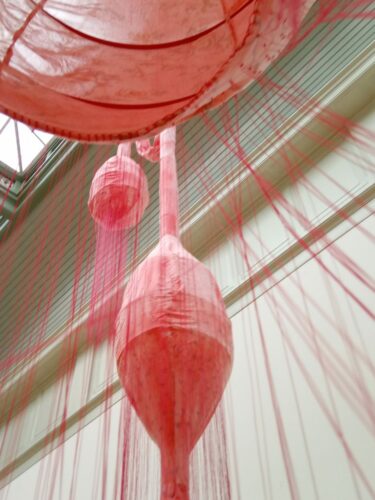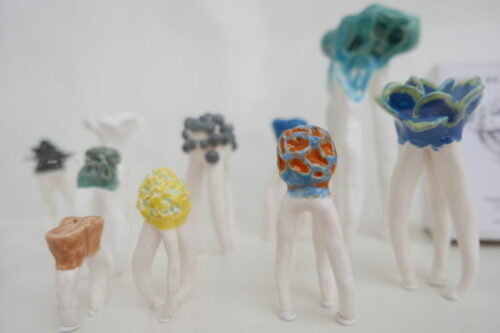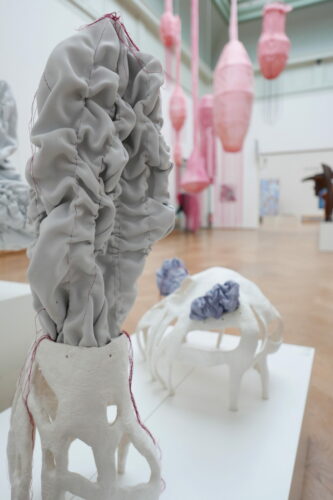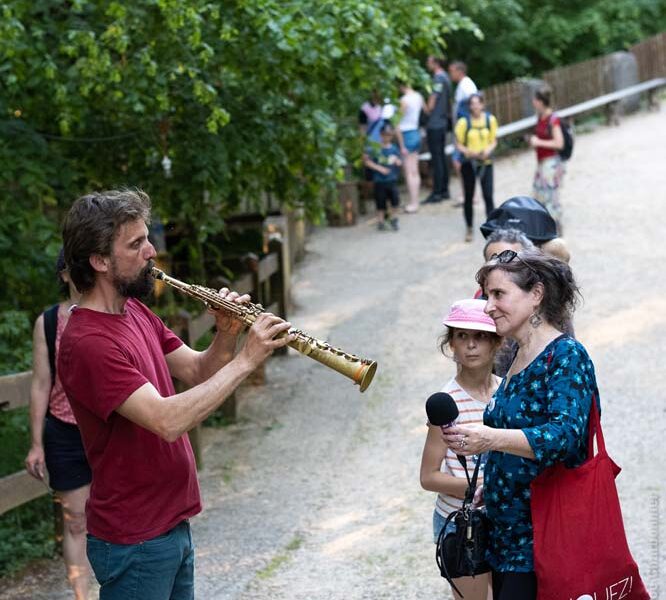In Nantes, there's a singular place where the stage takes on different forms and different meanings, on the bangs of academic approaches. At Studio d'en haut, artists from a variety of singular backgrounds find a free space in which to develop their projects. Meet Rasim Biyikli and Anthony Taillard, inventors of this place where the spirit of openness reigns.
We were lucky enough to start at a time when it was still possible to invent ourselves and our place," recalls Rasim Biyikli. Since 2008, Studio d'en haut has been a Leviathan, with no fixed, undefined form. It's a production space that welcomes projects that don't fit in with our expectations. We're interested in any project that's parallel, difficult, complex or requires research. A short while ago, we were talking to a former member of the Drac about support for artwork and research, so important for any artistic approach, but especially for experimental music. Well, they no longer exist!
Nursery, refuge and laboratory
To artists who would like to propose a project to Studio d'en haut, Anthony Taillard simply replies: "There's no selection! Proposals come in, that's all. Rasim is the pianist with the group Orange Blossom, which has been mixing world music and electro since 1993. Anthony, a rock and jazz guitarist, is passionate about electronic music and new lutheries. The two friends co-founded the studio with the initial idea of being able to manage their own musical activities, "to be autonomous and independent," continues Anthony. Then, some musician friends joined in. Like Australian percussionist Will Guthrie, from Nantes by adoption, who joined the project in 2012. The independence of the Studio d'en haut appealed to him: "I wanted to organize my projects in a different way from what we do in an institutional setting. My music didn't fit into the boxes of subsidized projects. The Studio d'en haut approach is more like the way artists run their projects back home in Australia: with much less financial support, the energy invested is not at all the same, the personal, artistic involvement is much greater."
All the artists who come through our doors have a spirit of openness, not conquest," insists Rasim. We defend a production that proposes new projects with artists who want to give of their body and their heart, in the hope that the public will accept this. There's a strong feeling that the tendency is to stroke the public in the direction of the hair, and very little to get them out of their comfort zone." Studio d'en haut is a producer, not a distributor. And distribution is sometimes difficult: "We don't fit into the expected boxes," continues Rasim. Which is bad for artistic diversity.
The list of artists who have worked and continue to work with Studio d'en haut is long and varied, and includes Thomas Tilly, Pierrick Sorin, Christophe Havard,Ensemble 0, Gaspar Claus and Sylvain Chauveau...
Le Studio d'en Haut - 2022 from Le Studio d'en Haut on Vimeo.
Studio d'en haut-style immersion
"Immersive" is undoubtedly the buzzword of the moment. "Immersive concerts", "participative", "experiences"... programmers are fond of these terms. These new devices designed to broaden access to concerts have Rasim and Anthony wondering. "We've also created an immersive experience with the artist Nguyen Le Hoang. Double Je. But the notion of immersive is a far cry from all the latest fashions: 3D headsets, etc., which, in our view, are blinkered. We're not fond of them. Our desire is to offer something immersive AND collaborative", explains Rasim. In concrete terms, the spectator finds himself at the center of four speakers, facing a video projection: a living-room interior. Accessories are arranged here and there: a few books on a shelf, a photo frame on the table, children's toys on the carpet. The changing light offers a multiplicity of viewpoints, and characters appear in image or voice. We listen to the atmosphere, the sound effects, the voices, the breaths, the sighs. Music adds to the mix, titillating the imagination.
Experimental music redefines the relationship with the stage
But immersion is also born on stage, and not just through digital devices. Will Guthrie has just returned from a tour of Scandinavia with his gamelan ensemble Nist Nah. "Anthony suggested that I set up a project with the support of Studio d'en haut and the Nantes venue La Soufflerie. La Soufflerie. I'd been wanting to work with Javanese gamelans for a long time; I studied this fascinating instrument in Australia, during my time at the conservatoire. I didn't dare... I didn't feel legitimate, I'm not Indonesian, it's not my culture". For Will, the concert has one vocation: to connect with the music, which alone drives the performance. The fashion for "new forms of concert" makes him smile. "We've been doing immersive concerts for a very long time, in experimental music! For the last 20 years, I've been playing my solos in the middle of the room and in front of people, so the idea of being on stage with the audience in front of you is long gone. Playing on stage, far from the audience, is not satisfying. Experimental music is constantly redefining the relationship to the stage, intuitively, without even asking the question."
Film, record, motorize, improvise
As for Anthony, he's behind an explosive three-volume project that's both visual and sonic: "Immensity of the Territory". The idea is a little crazy: fascinated by the spirit of American road movies, the guitarist mixed phonographies collected during three trips to the USA and Canada with electric guitars. Some are augmented by motorized devices that are controlled remotely! "The project was released on record, but it also exists on stage: our trio plays and composes the music live while we screen the films we shot in America." The first two shows referenced westerns, road movies and the New Wave. The latest opus plunges the listener into pioneering explorations along the Missouri River, the wide-open spaces of Montana, the industrial sites lining Michigan and the forests of Canada.
Concert or installation? At the crossroads
More recently, Rasim and Anthony put their inventor's hats back on and came up with "Dédale", another singular project that reshuffles the cards of the concert as we imagine it: the experience is at the crossroads of sound installation and a concert whose form changes perpetually. A prepared piano, an electric guitar, an organ with floppy disk drive and other crazy prototypes come together. The two artists remotely control these robotic instruments to compose a live symphony. " The 'Dédale' experience can be enjoyed alone or with an audience," says Anthony.
And the experimentation continues. Studio d'en haut is preparing a collaboration with visual artist Sophie Papiau. " We'd like to add sound to the textil and ceramic sculptures she created for the Pink Forest exhibition . In Nantes, there's a singular place where new sound and musical experiences are being invented, led by artists who are convinced that, today, it's possible to reach out to audiences where they least expect it, and take them to places that are more invigorating than ever.



Suzanne Gervais



)



